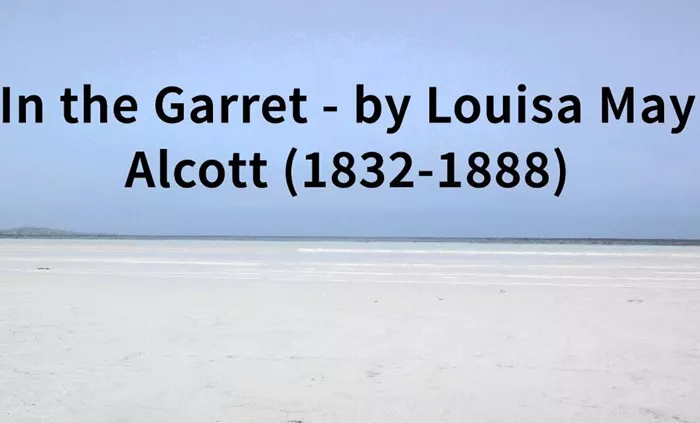Welcome to Poem of the Day – In the Garret by Louisa May Alcott
Louisa May Alcott is widely known for her heartfelt stories and clear moral voice. But beyond her novels, she was also a talented poet. Her poem In the Garret shows her gift for capturing deep emotion through simple, powerful language. This article explores the meaning, tone, and structure of the poem, offering a clear and thoughtful explanation for readers who wish to connect more deeply with Alcott’s work.
In the Garret Explanation
Setting the Scene: What Is a Garret?
A garret is a small attic room, often tucked away under the roof of a house. In the past, these spaces were used by poor artists, writers, or people seeking quiet. The garret in this poem is not just a place; it becomes a symbol of memory, change, and the passage of time.
Summary of the Poem
The speaker looks back on a time when she and a loved one shared the garret. They were young, full of dreams, and poor, but happy. The room was filled with laughter, stories, and simple joys. Years later, the speaker returns. The garret is now silent and empty. Dust has settled on old things. Yet the spirit of the past still lingers in the air.
The poem moves gently from joy to sorrow. It begins with memories of companionship and ends with quiet reflection on how life changes. Though the people are gone, the garret remains, holding their stories.
Themes in the Poem
1. Memory and Nostalgia
The heart of the poem lies in memory. Alcott uses simple images—a worn-out chair, a faded curtain, an old pen—to stir up feelings of the past. The reader is invited to see the space as it once was, full of life and love.
2. The Passage of Time
Time is another strong theme. In the beginning, the garret is a place of hope and creativity. Later, it becomes a symbol of what is lost. Yet, even in its silence, it holds the warmth of past days. This contrast between then and now gives the poem its emotional depth.
3. Simplicity and Contentment
The poem also highlights how happiness does not depend on wealth or success. In the early part of the poem, the characters live simply, but they are rich in love and purpose. Alcott reminds us that joy can be found in the smallest of places.
Tone and Mood
The tone of the poem changes gradually. At first, it is cheerful and warm. Alcott uses light, playful language to describe the good times in the garret. As the poem progresses, the mood becomes more thoughtful and calm. There is a quiet sadness in the final lines, but also a deep sense of peace.
Structure and Language
In the Garret is written in a straightforward, lyrical style. The lines are clear and not overly complex. This makes the emotions easy to feel. The rhythm flows smoothly, like someone softly telling a story.
Alcott uses strong visual imagery. She brings the room to life with simple details. Her use of contrast—between past and present, noise and silence—adds power to the poem. The language is not flowery, but it is full of heart.
Personal Meaning and Universal Message
Though the poem speaks of one small attic room, its message is universal. Everyone has a place they remember. Everyone has known change, loss, or longing. Alcott captures this feeling in a way that feels both personal and shared.
The garret is a space of dreams. It is a space where love once lived. Even though time has passed, the memory remains. This is what gives the poem its lasting strength.
Conclusion
In the Garret by Louisa May Alcott is a tender poem about memory, change, and the quiet power of simple things. It shows us that even the smallest room can hold great meaning. Through clear language and heartfelt emotion, Alcott paints a picture of the past that still speaks to readers today.
Whether read for comfort, reflection, or inspiration, this poem offers a gentle reminder: the places we love may change, but the love we felt there remains.


